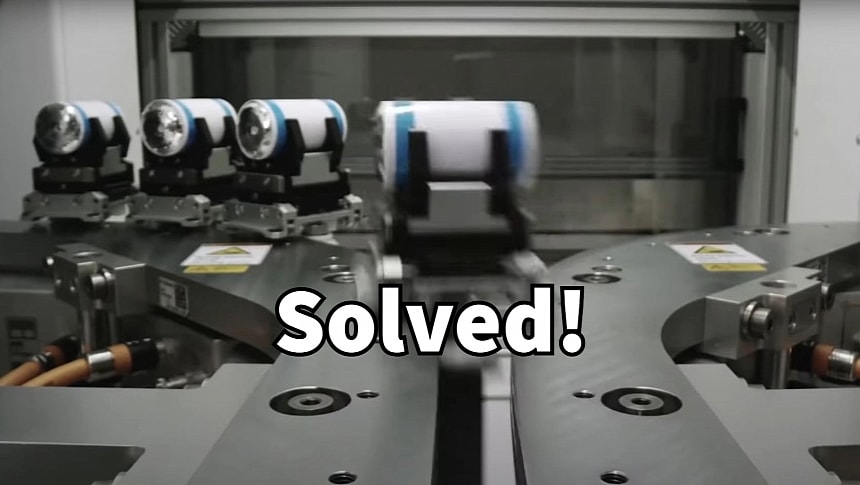New reports indicate that Tesla has finally solved the dry electrode coating process, paving the way for much cheaper 4680 cells. The EV maker is focusing on scaling up production, with plans to bring the improved 4680 cells to market by the end of the year.
Not long ago, a report from China indicated that Tesla was contemplating killing its battery business. When Elon Musk went on a firing spree in May, the battery team seemed to be heading for the chopper board, following the Supercharger team into nothingness. This actually made sense, considering that Tesla has been struggling for five years to crack the battery electrode process that would make the 4680-cell prophecy come true.
But first, let's refresh our memory with Tesla's in-house battery production. Elon Musk introduced the 4680 cells to the public during the 2020 Battery Day. However, the plans to start internal development of these cells were laid out much earlier, leading to Tesla buying Maxwell in 2019. Maxwell was working on a revolutionary dry electrode coating process for its supercapacitor production. Tesla saw the potential of the technology for its battery manufacturing, making the move on Maxwell. In 2021, Tesla sold Maxwell's supercapacitor business, although it kept the dry battery electrode (DBE) tech for itself.
The dry electrode coating, or dry battery electrode manufacturing process, allows massive cost reduction during the manufacturing of Li-ion cells. Traditionally, battery electrodes are a slurry that needs to be dried for the final assembly process, which takes time and is energy-hungry. That's why DBE can potentially lower production costs by 50%. Tesla bet almost anything on mastering this technology but without much results.
So far, Tesla's 4680 cell production uses the DBE process for the cheaper negative electrode (anode). The more expensive positive electrode (cathode) is still a traditional (wet) electrode purchased from LG and two other Chinese companies. This means that producing the 4680 cells is still more expensive than buying 2170 cells from suppliers like LG or Panasonic. However, things are set to change.
A new report from China claims that Tesla has finally solved the cathode dry coating process, paving the way for a massive cost reduction for its 4680 cells. This will allow it to produce both the anode and the cathode using DBE tech. Although the process was perfected in 2022 and proved successful in the lab, scaling it into production has been a nightmare, with abysmal yields.
According to the LatePost report, the problem was that dry-coated cathode rolling machines kept breaking because the cathode material was much harder than the anode material. Each breakdown would lead to 45 days of downtime, contributing to spiraling costs at Tesla's battery department. The solution was replacing the equipment with better machines, but that would have required additional costs that Tesla management did not approve at the time.
This has changed, though, as Tesla is confident it has completed the development cycle and is now starting to prepare engineering optimization for volume production. There's still a lot of work to optimize the process and scale production, but the most difficult part of the DBE process has been solved. If the LatePost report gets it right, Tesla might start volume production of the new Cybercell 2.0 batteries by the end of the year.
But first, let's refresh our memory with Tesla's in-house battery production. Elon Musk introduced the 4680 cells to the public during the 2020 Battery Day. However, the plans to start internal development of these cells were laid out much earlier, leading to Tesla buying Maxwell in 2019. Maxwell was working on a revolutionary dry electrode coating process for its supercapacitor production. Tesla saw the potential of the technology for its battery manufacturing, making the move on Maxwell. In 2021, Tesla sold Maxwell's supercapacitor business, although it kept the dry battery electrode (DBE) tech for itself.
The dry electrode coating, or dry battery electrode manufacturing process, allows massive cost reduction during the manufacturing of Li-ion cells. Traditionally, battery electrodes are a slurry that needs to be dried for the final assembly process, which takes time and is energy-hungry. That's why DBE can potentially lower production costs by 50%. Tesla bet almost anything on mastering this technology but without much results.
So far, Tesla's 4680 cell production uses the DBE process for the cheaper negative electrode (anode). The more expensive positive electrode (cathode) is still a traditional (wet) electrode purchased from LG and two other Chinese companies. This means that producing the 4680 cells is still more expensive than buying 2170 cells from suppliers like LG or Panasonic. However, things are set to change.
A new report from China claims that Tesla has finally solved the cathode dry coating process, paving the way for a massive cost reduction for its 4680 cells. This will allow it to produce both the anode and the cathode using DBE tech. Although the process was perfected in 2022 and proved successful in the lab, scaling it into production has been a nightmare, with abysmal yields.
According to the LatePost report, the problem was that dry-coated cathode rolling machines kept breaking because the cathode material was much harder than the anode material. Each breakdown would lead to 45 days of downtime, contributing to spiraling costs at Tesla's battery department. The solution was replacing the equipment with better machines, but that would have required additional costs that Tesla management did not approve at the time.
This has changed, though, as Tesla is confident it has completed the development cycle and is now starting to prepare engineering optimization for volume production. There's still a lot of work to optimize the process and scale production, but the most difficult part of the DBE process has been solved. If the LatePost report gets it right, Tesla might start volume production of the new Cybercell 2.0 batteries by the end of the year.







